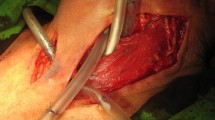Abstract
The aims of this investigation were to review the clinical behavior of deep neck infections (DNIs) treated in our institution in order to identify the predisposing factors of life-threatening complications and propose valuable recommendations for management and treatment. A total of 365 adult patients with DNIs were retrospectively identified. One-hundred and thirty-nine patients (38.1%) underwent surgical drainage. Overall, 226 patients (61.9%) responded effectively to intravenous antimicrobial therapy only. There were 67 patients (18.4%) developing life-threatening complications. Diabetes mellitus (odd ratio 5.43; P < 0.001) and multiple deep neck spaces involvement (odd ratio 4.92; P < 0.001) were the strongest independent predictors of complications. The mortality rate was 0.3%. Airway obstruction and descending mediastinitis are the most troublesome complications of DNIs. In selected patients, a trial of intravenous antibiotic therapy associated with an intensive computed tomography-based wait-and-watch policy may avoid an unnecessary surgical procedure. However, about one-fourth of patients present significant comorbidities, which may negatively affect the course of the infection. In these cases and in patients with large or multiple spaces infections, a more aggressive surgical strategy is mandatory.





Similar content being viewed by others
References
Daramola OO, Flanagan CE, Maisel RH et al (2009) Diagnosis and treatment of deep neck space abscesses. Otolaryngol Head Neck Surg 141:123–130
Reynolds SC, Chow AW (2007) Life-threatening infections of the peripharyngeal and deep fascial spaces of the head and neck. Infect Dis Clin North Am 21:557–576
Brook I (2004) Microbiology and management of peritonsillar, retropharyngeal, and parapharyngeal abscesses. J Oral Maxillofac Surg 62:1545–1550
Levitt GW (1970) Cervical fascia and deep neck infections. Laryngoscope 80:409–435
Lin HT, Tsai CS, Chen YL et al (2006) Influence of diabetes mellitus on deep neck infection. J Laryngol Otol 120:650–654
Boscolo-Rizzo P, Da Mosto MC (2009) Submandibular space infection: a potentially lethal infection. Int J Infect Dis 13:327–333
Brook I (2007) The role of anaerobic bacteria in upper respiratory tract and other head and neck infections. Curr Infect Dis Rep 9:208–217
Leibovici L, Yehezkelli Y, Porter A (1996) Influence of diabetes mellitus and glycaemic control on the characteristics and outcome of common infections. Diabetic Med 13:457–463
Slovenkai MP (1998) Foot problems in diabetes. Med Clin North Am 82:949–971
Lassmann B, Gustafson DR, Wood CM et al (2007) Reemergence of anaerobic bacteremia. Clin Infect Dis 44:895–900
Brook I (2010) β-Lactamase-producing bacteria in upper respiratory tract infections. Curr Infect Dis Rep 12:110–117
Moran GJ, Krishnadasan A, Gorwitz RJ et al (2006) Methicillin-resistant S. aureus infections among patients in the emergency department. N Engl J Med 355:666–674
Popovich KJ, Weinstein RA, Hota B (2008) Are community-associated methicillin-resistant Staphylococcus aureus (MRSA) strains replacing traditional nosocomial MRSA strains? Clin Infect Dis 46:787–794
Nagy M, Backstrom J (1999) Comparison of the sensitivity of lateral neck radiographs and computed tomography scanning in pediatric deep-neck infections. Laryngoscope 109:775–779
Boscolo-Rizzo P, Marchiori C, Zanetti F et al (2006) Conservative management of deep neck abscesses in adults: the importance of CECT findings. Otolaryngol Head Neck Surg 135:894–899
Elden LM, Grundfast KM, Vezina G (2001) Accuracy and usefulness of radiographic assessment of cervical neck infections in children. J Otolaryngol 30:82–89
Wang LF, Tai CF, Kuo WR et al (2010) Predisposing factors of complicated deep neck infections: 12-year experience at a single institution. J Otolaryngol Head Neck Surg 39:335–341
Smith JL, Hsu JM, Chang J (2006) Predicting deep neck space abscess using computed tomography. Am J Otolaryngol 27:244–247
Kirse DJ, Roberson DW (2001) Surgical management of retropharyngeal space infections in children. Laryngoscope 111:1413–1422
Gahleitner A, Watzek G, Imhof H (2003) Dental CT: imaging technique, anatomy, and pathologic conditions of the jaws. Eur Radiol 13:366–376
Giyanani VL, Mirfakhraee M, Gerlock AJ et al (1985) Computed tomography of internal jugular thrombosis. J Comput Assist Tomogr 9:33–37
Ridder GJ, Maier W, Kinzer S et al (2010) Descending necrotizing mediastinitis: contemporary trends in etiology, diagnosis, management, and outcome. Ann Surg 251:528–534
Allan AG (2004) Reluctance of anaesthetists to perform awake intubation. Anaesthesia 59:413
Boyanova L, Kolarov R, Mitov I (2007) Antimicrobial resistance and the management of anaerobic infections. Expert Rev Anti Infect Ther 5:685–701
Sichel JY, Dano I, Hocwald E et al (2002) Non surgical management of parapharyngeal space infections: a prospective study. Laryngoscope 112:906–910
Boscolo Rizzo P, Scotton PG, Da Mosto MC et al (2003) Sindrome di Lemierre da Streptococcus constellatus. Caso clinico e rassegna della letteratura. Giorn It Mal Inf 9:167–170
Syed MI, Baring D, Addidle M et al (2007) Lemierre syndrome: two cases and a review. Laryngoscope 117:1605–1610
Conflict of interest
There are no potential conflicts of interest.
Author information
Authors and Affiliations
Corresponding author
Rights and permissions
About this article
Cite this article
Boscolo-Rizzo, P., Stellin, M., Muzzi, E. et al. Deep neck infections: a study of 365 cases highlighting recommendations for management and treatment. Eur Arch Otorhinolaryngol 269, 1241–1249 (2012). https://doi.org/10.1007/s00405-011-1761-1
Received:
Accepted:
Published:
Issue Date:
DOI: https://doi.org/10.1007/s00405-011-1761-1




